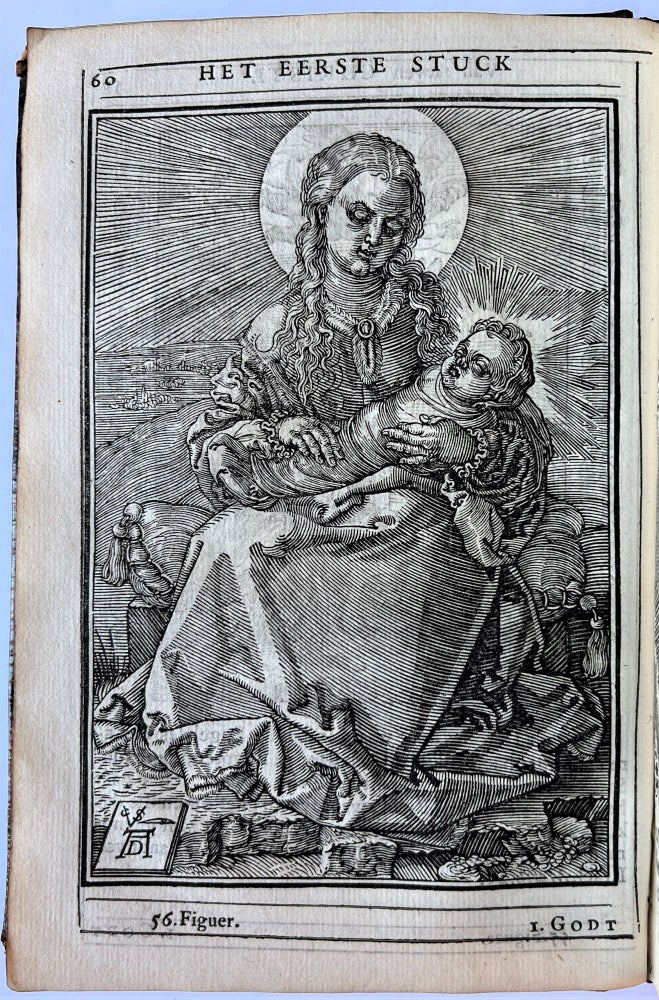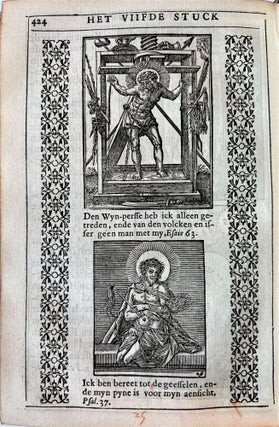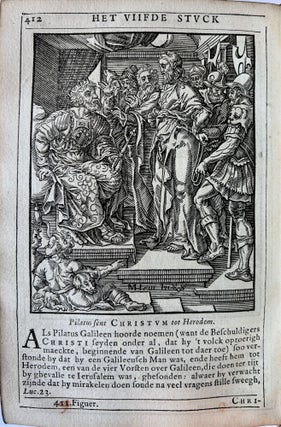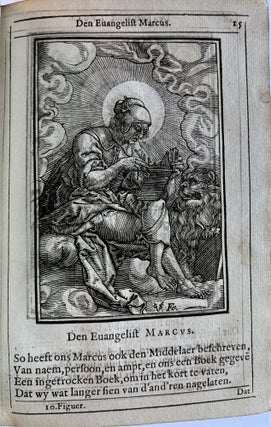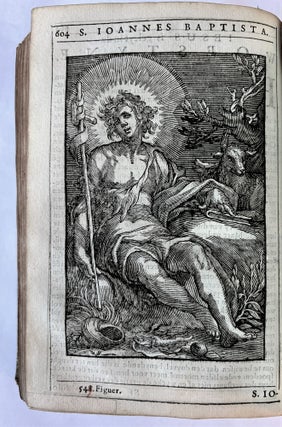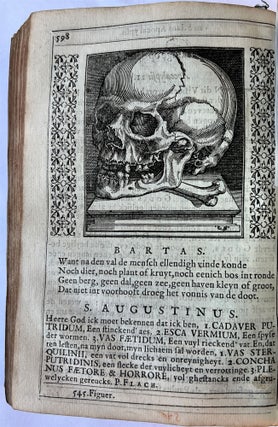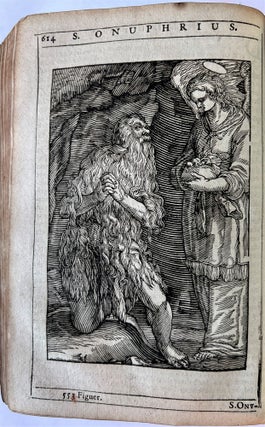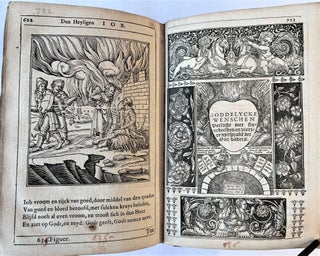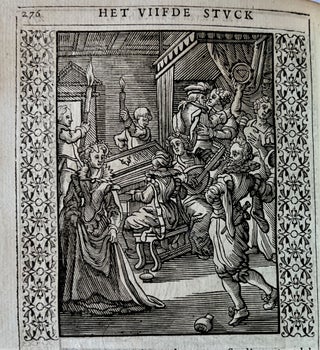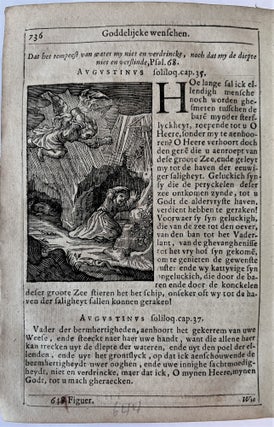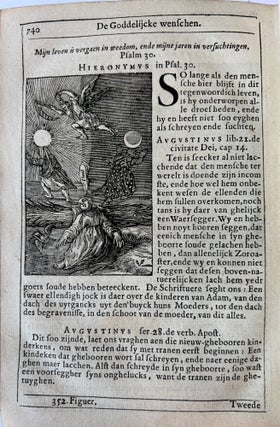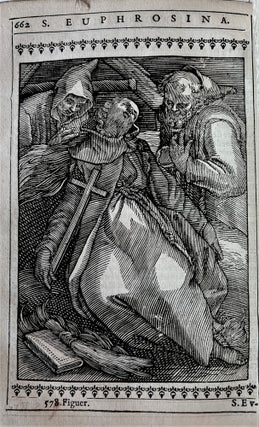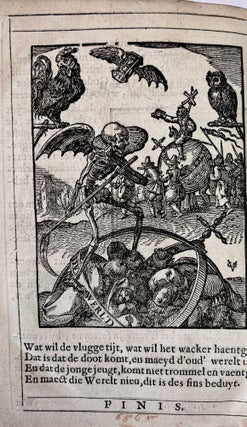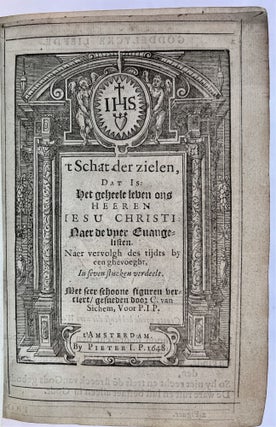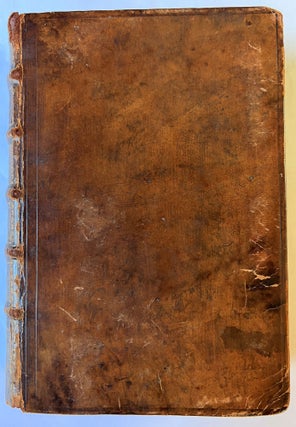`t Schat der zielen, Dat is: het geheele leben ons Heeren Iesu Christi: Naer de vyer Evangelisten. Amsterdam: P[ieter] I[acobsz] P[aets], 1648.
4to (175 x 114 mm). “800” [recte 764], [4] pages. 3 parts, separately titled, continuously paginated and signed, with numerous pagination errors. Titles within woodcut borders, 686 woodcut illustrations, most signed with Sichem’s monogram, numbered at the foot of the pages (with errors), most three-quarter page, most flanked by type ornament borders, rule borders throughout. Figures 51 (D4r) and 478 (K6v) are cancels pasted down (as usual) over the original illustrations. A leaf from a different illustrated work, on thicker paper, is bound between fols. P8 and Q1 (pp. 242 and 243 [mispaginated 743]). Extreme upper margin of title restored, dampstain in quires L-M, dust-soiling. Bound in 18th-century calf, spine gold-tooled with morocco lettering piece, edges red-stained (edge wear, head of spine broken, joints starting). Provenance: Unidentified armorial bookplate, signed “N: Heÿlbrouck fecit”; a 20th-century owner corrected the numerous errors to the picture numbering in pencil and red chalk, with occasional notes in French.***
Only Edition thus of an unusual illustrated devotional book, a tour de force of woodcut production by the great Dutch wood cutter Christoffel van Sichem II (1581-1658). With nearly 700 woodcuts, the edition in places evokes a graphic novel. Sichem copied an encyclopaedic array of Netherlandish and German sources, including Abraham Bloemart, the brothers Wierix, Aldegrever, Goltzius, Boëce van Bolswert, Lucas van Leyden, Joannes Stradanus and Dürer. His accurate white-on-black reproductions of engravings, such as of Bolswert and Bloemart’s engravings in part 3, ‘t Bosch der eremyten ende eremytinnen, foreshadow 19th-century reproductive wood-engraving.
The edition is densely printed, on inexpensive paper. The printer/publisher Paet’s goals in issuing this and other devotional works illustrated by Sichem were the same as those of his successors two centuries later: to make illustrations available cheaply, in this case to the devout middle-class readers who could not afford books with engravings, but who would be eager to buy an all-in-one vernacular devotional companion to bring the stories of the Bible to life and assist in daily prayers and meditations. A compendium both of texts and of Sichem’s woodcut oeuvre, the book is in three parts, the first and longest, the “Treasure of Souls, or Life of Christ,” itself containing seven parts. This is the only edition, although some of the woodcuts probably appeared previously. A sort of New Testament picture Bible, it complements the Old Testament focus of Sichem’s Bibels tresoor, ofte Der zielen lusthof, published by Paets in 1646. Each page contains a large woodcut, sometimes letter-keyed to the text, paraphrased from the Bible. Some passages, such as the Passion of St. John and the Apostles’ Creed, are illustrated with two small woodcuts per page. Part 2 is ‘t Bosch der eremyten ende eremitinnen, whose text by the Jesuit hagiographer Heribert Rosweyde was first published in Latin and Dutch in 1619 with engraved illustrations by Boëce van Bolswert after Bloemaert. Earlier editions with Sichem’s woodcuts appeared in 1644 and 1645. The third part, Goddelycke Wenschen, is the Dutch version of Herman Hugo’s emblem book, Pia desideria (first published 1624), which owed its huge popularity to Bolswert’s 45 fetching engraved emblems, here marvelously copied in wood by Sichem. Sichem’s woodcuts had first appeared in the second Latin edition, in 1628, and he, or Paets, used them in other works as well, such as the Bibels Tresoor.
The son of an engraver and wood cutter, Christoffel II Sichem worked exclusively in wood, leaving no known copper engravings. His mastery of a range of styles is impressive. He could as readily cut Renaissance-style white-on-black bandeaux (used, for example on the title-page of Goddelycke Wenschen) or night-time scenes of Hugo’s child-soul seeking grace, as a beautiful copy of Dürer’s Madonna (p. 60). It has not escaped notice how much Sichem’s white-line woodcuts resemble wood engraving. The practice of engraving with the burin or graver on the endgrain of wood (rather than cutting the wood with a knife on the plank side) was known already by Dutch printmakers in the first half of the 18th century, but Arthur Hind reported that while Sichem’s white-line xylographic prints “appear at first sight to be graver work ... a careful examination of their white lines renders it more probable that [he] still used the knife” (History of Woodcut vol. I, p. 10).
OCLC cites 5 US locations. STCN 842875999; Hollstein XXVII, p. 51 (no. 52); cf. Thieme-Becker 30:586. Item #4150
No longer available
Status: On Hold

